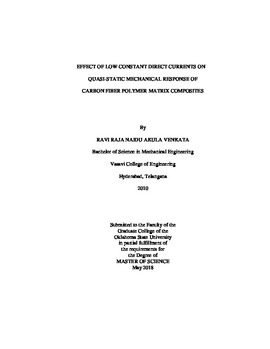| dc.contributor.advisor | Singh, Raman Pal | |
| dc.contributor.author | Akula Venkata, Ravi Raja Naidu | |
| dc.date.accessioned | 2019-05-08T18:36:50Z | |
| dc.date.available | 2019-05-08T18:36:50Z | |
| dc.date.issued | 2018-05-01 | |
| dc.identifier.uri | https://hdl.handle.net/11244/319623 | |
| dc.description.abstract | Carbon-fiber reinforced composites (CFRP) can be subjected to two different levels of direct current conduction, either under catastrophic high current conditions such as lightning-strike on an aircraft structure or under low constant current conditions as in multifunctional composite structures used for resistive heating, energy harvesting and distribution. While the effect of high currents for short durations on mechanical properties of CFRP are well studied, effects of long-term exposure to relatively low constant direct currents are studied less. The focus of this study is to measure the change in mechanical properties of CFRP subjected to constant low direct current of different intensities and durations. In the present investigation sixteen ply unidirectional CFRP laminates made of IM7 carbon fiber and Diglycidyl ether of bisphenol-F (DGEBF) based epoxy are fabricated using vacuum assisted resin transfer moulding (VARTM) technique. Samples of two different sizes namely coupon (127 mm x 12.7 mm) and plate sizes (254 mm x 177.8 mm) are snug fitted between copper electrodes along the fiber direction and are exposed to two different levels of electric current intensities (0.062 A/mm2 and 0.093 A/mm2) under constant direct current mode for three and six hours. The corresponding change in the voltage which is direct measure of change in resistance of the sample is recorded and logged in a spreadsheet with the help of a BASIC based power supply instruction code. Conduction path within the composite sample is mapped by measuring and logging its surface temperatures continuously using far infrared sensor array (16 x 4 resolution) within a total field of view of 120° x 30° across entire width of the sample at mid-length. Subsequently, the mechanical properties of samples corresponding to current exposed, oven heated and as-is conditions are tested as per ASTM D6641 (combined loading compression test) to determine and compare the maximum compressive strengths. Glass transition temperatures which is a reliable indicative of polymer strength is measured using Differential Scanning Calorimetry (DSC) for all categories of exposure namely, current exposed, oven heated and as-is samples. Compression strength results have shown no significant change for all kinds of exposure. Voltage-time curves indicate a linear increase in the resistance of the current exposed CFRP sample. However, there is a lot of noise in the voltage history plot which is apparently due to the hotspot formation at the electrode and sample interface. Temperature history plots show a very slow rate of linear increase in temperatures. Glass transition temperatures support the 'no change' claim by maximum compression strength results by indicating no percentage change in glass-transition temperatures of as-is, current and oven exposed sample. | |
| dc.format | application/pdf | |
| dc.language | en_US | |
| dc.rights | Copyright is held by the author who has granted the Oklahoma State University Library the non-exclusive right to share this material in its institutional repository. Contact Digital Library Services at lib-dls@okstate.edu or 405-744-9161 for the permission policy on the use, reproduction or distribution of this material. | |
| dc.title | Effect of Low Constant Direct Currents on Quasi-Static Mechanical Response of Carbon Fiber Polymer Matrix Composites | |
| dc.contributor.committeeMember | Sallam, Khaled A. | |
| dc.contributor.committeeMember | Vaidyanathan, Krishnan Ranji | |
| osu.filename | AkulaVenkata_okstate_0664M_15766.pdf | |
| osu.accesstype | Open Access | |
| dc.description.department | Mechanical and Aerospace Engineering | |
| dc.type.genre | Thesis | |
| dc.type.material | Text | |
